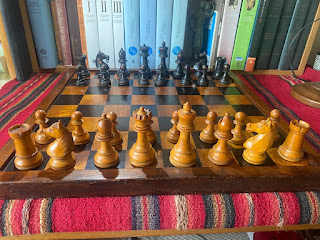Reviving the Brilliance: Unveiling the Best Wax for Your Worn Wooden Chessboard
Chess is a game that has been enjoyed for centuries, and it's not uncommon to find older chessboards that have seen their fair share of wear and tear. If you're in possession of such a board and are looking to revive its beauty, you may be wondering which type of wax is best suited for the job. As a man of science, I embarked on a proper experimental setup to determine the ideal wax for an old wooden chessboard. In this blog, I will share my findings and provide insights into the performance of different waxes.
Experimental Setup:
To conduct a controlled experiment, I divided the chessboard into four quadrants using painter's tape. One quadrant was left untouched as a control, while I applied different waxes to the other three quadrants. The waxes I chose for this experiment were natural wax, beeswax, car wax (Turtle brand), and a synthetic wax, Renaissance wax, commonly used in British museums for artifact preservation. Each wax is composed of unique materials that contribute to its properties and performance.
- Car Wax (Turtle Brand):
- Synthetic Wax (Renaissance Wax):
- Natural Wax (Beeswax):
Car wax, such as the popular Turtle brand, is typically made from a blend of natural waxes, polymers, and silicone oils. These ingredients work together to provide a protective layer and a glossy finish to the surface they are applied to. The polymers in car wax help fill in small scratches and imperfections, while the silicone oils create a water-repellent barrier. The result is a shiny surface that can enhance the appearance of the chessboard.
Observations:
Car wax gave a nice shine to the chessboard, improving its visual appeal. However, it created a slippery surface, causing the chess pieces to glide too easily. This could potentially affect the precision of moves during gameplay.
Renaissance wax, a synthetic wax widely used in the preservation of artifacts in British museums, is formulated using a combination of microcrystalline waxes, synthetic polymers, and other additives. Microcrystalline waxes are derived from petroleum and are known for their excellent durability and water resistance. The synthetic polymers enhance the wax's adhesive properties and provide a protective layer against environmental factors.
The synthetic Renaissance wax provided a beautiful satin-like finish when applied to the chessboard. It hardened almost immediately, forming a durable and long-lasting protective shell. This wax is designed to withstand the test of time and ensure the preservation of delicate artifacts. If you prioritize durability and protection for your chessboard, the synthetic Renaissance wax is an excellent choice.
Beeswax, as the name suggests, is derived from the wax produced by honeybees. It is a natural wax known for its pleasant aroma and versatility. Beeswax contains esters, hydrocarbons, and fatty acids, which contribute to its unique properties. It is commonly used in various applications, including woodworking and furniture care.
Observations: Beeswax provided the chessboard with a lovely glow when applied. Although it initially felt somewhat oily, it eventually lost that texture and cured to produce astonishing results. After around 20 minutes, the beeswax offered an alluring luster and enhanced playability. If you seek a combination of a brilliant luster and smooth playability for your chess pieces, beeswax is the way to go.
Conclusion:
Based on my experiment and observations, the choice of wax for an old wooden chessboard depends on your preferences. If you want the chess pieces to glide effortlessly across the board, car wax can provide a shiny surface. However, if you prioritize durability and protection for your chessboard, the synthetic Renaissance wax is an excellent option due to its microcrystalline structure. Lastly, if you desire a beautiful luster and enhanced playability, beeswax is the way to bring life back into your old chessboard.
Remember, these findings are based on my personal experiment, and your preferences may vary. It's always advisable to test a small area of your chessboard before applying wax to the entire surface.
Revive the beauty of your old wooden chessboard with the right wax, and let the game of kings continue on a surface that truly shines.
If you would like to see the experiment, you may check out the video below:



Comments
Post a Comment